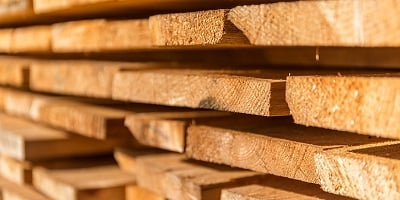Growth in the engineered wood category is exploding. This sturdy, composite wood product is on the fast track to become a $400 BILLON industry by 2027. Why is the demand so high and growing so rapidly? How, where, and why should you use engineered wood in your commercial or residential construction jobs? Below, we discuss the pros and cons of engineered lumber. But first, a little history.
History of Engineered Wood
Engineered wood is nothing new. Laminated and glued wood has been found in materials dating as far back as the time of Egyptian pharaohs. In more recent times, plywood was introduced as a less expensive alternative to regular sawn lumber, and its popularity soared. Over the years, engineered lumber has been improved and strengthened to become the impressive product used today in many construction jobs. Modern engineered lumber is a fantastic product that offers many advantages over regular wood, but understanding how, where and when to use it is important.
[INSET:] Engineered wood includes “I-Beams, plywood, laminated veneer lumber (LVL), glulam (glued laminated timber), oriented strand boards (OSB), cross-laminated timber (CLT), and others.” – Allied Market Research
Engineered Wood Benefits
Engineered lumber is known by many names, including composite wood, mass timber, man-made wood, and manufactured board just to name a few. But what is it? The materials can vary with different manufacturers, but essentially it is a mix of products that can include wood, wood fiber, veneers, glue, plastic, wood strands and sawdust. They are manufactured (typically heated and/or extruded) to bond together, creating a stronger, sturdier product than traditional lumber and used in industries including construction, flooring, furniture, and packaging, just to name a few.
With the fluctuations in the price of lumber - particularly since the onset of the COVID-19 pandemic, which caused a huge boom in the construction, renovation, and remodeling industry—the price of lumber has dramatically increased due to high demand. More and more contractors are choosing engineered wood for remodeling and renovation products due to its steadier price, long life, and sturdy results. Engineered wood can be a little more expensive than wood, but with the demand for regular lumber and the long-lasting results that need fewer repairs; it can be worth the additional investment. The long-term benefits you get from engineered wood are…well, solid, if you’ll pardon the pun.
Here are some of the pros of engineered lumber:
-
More environmentally friendly: Particularly important when building in “green building” areas.
-
Beauty and flatness: Ideal for “make it count” areas in the home where aesthetics are of primary importance and there’s no room for flaws, like high walls, or tiled areas and countertops in kitchens and bathrooms.
-
Strength: Superior structural integrity when compared to regular wood.
-
Quality: Reduction of costly post-installation quality issues, such as having to repair joists.
-
No special tools: Can be cut, machined, and used with regular woodworking tools. As this material is denser than regular wood, consider using SCRAIL® fasteners, which can dramatically increase the speed of your installation work.
[INSET:] FYI: The Engineered Wood Association publishes the Engineered Wood Construction Guide—an authoritative, 100-page guide to building walls, roofs and floors with engineered wood for both residential and commercial construction.
Drawbacks of Engineered Lumber
Despite the dramatic increase in demand for engineered wood, some contractors and workers are less familiar with it or perceive regular lumber to be easier and/or cheaper. Here are a few of the challenges in working with engineered wood:
-
Interior preferred: While composite wood designed specifically for exteriors can be used for outdoor areas such as decks, most engineered wood is best used on interiors, and is not good for areas that can or will get wet as it can’t absorb leaks and will rot faster.
-
Weight: It’s a heavier material, so you must factor that in when constructing standing walls. You may need additional labor to handle engineered wood.
-
Experience: Some contractors are not familiar with engineered wood and may have a bad impression of it being difficult or expensive to use.
-
Precision required: There is less margin for error with engineered wood. You need to measure and cut precisely as mistakes can cost more to fix than with dimensional wood.
-
Cost: While the price is more stable, engineered wood is generally more expensive than traditional lumber.
Working Smarter with Engineered Wood
Engineered lumber isn’t perfect for every construction job, but for the increased spend, you get more stability, strength, and longevity, with a flat, straight finish that makes for beautiful aesthetics. With engineered wood, you’ve also got that more environmentally friendly product with fewer potential future issues that you’ll have to go back and fix, like floor joist bumps and dips.
Work smarter when you use engineered wood, and the benefits will be many. Measure carefully and use tools that are designed for keeping you on track, on time and on budget, such as a pneumatic SCRAILer and use with threaded SCRAIL® fasteners from the BECK Group, which punch faster into this denser material. You can see the speed comparison of using SCRAIL® fasteners vs. bulk and collated screws in our video here.
.svg.png)


